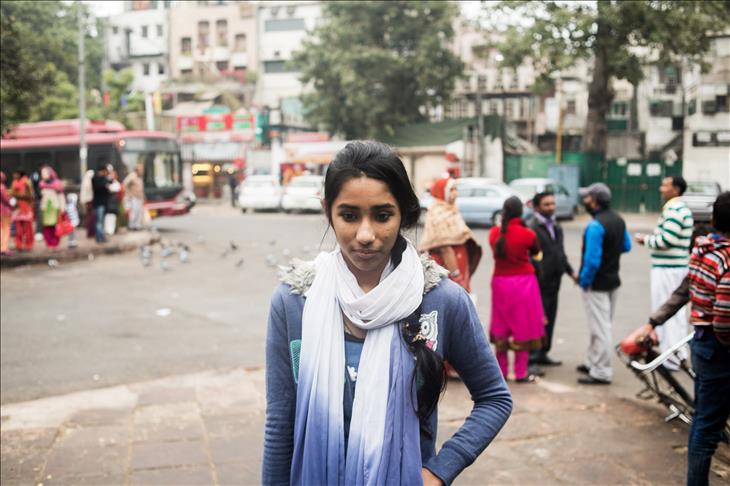
By Saurabh Yadav
DELHI
Global cities are defined by their public transport systems. With a population of 25 million, India's capital Delhi is a city on the move. For the women who use the transport system, though, it is sometimes a struggle to navigate it.
On December 16, 2012, a young woman was gang raped and brutally assaulted while on her way home after watching the late night showing of a movie. Her death, 13 days later, shook the nation's conscience, and protests filled the streets of Delhi and other cities in India for days afterwards.
"I was out on the streets during those days," remembers Vrinda Narang, a 20-year-old student at the time. "My parents were worried that I would get hurt because the police were hitting the protestors and teargasing them, but I went anyway because I believed in it."
The Delhi metro system, a suburban electric train system, is the lifeline of Delhi. It serves the suburbs and satellite towns around the capital state. With clean, air-conditioned coaches, trains running every few minutes on dedicated tracks and a coach especially reserved for women on every train, it is perhaps the most reliable mode of transportation in the city.
Hockey player Ashna Salmani, 16, uses it, as does 26-year-old Neha Chowdhury. "I always use the metro, but in the women's section as I don't have eyes looking at me all the time,” says Neha. “I don't feel safe in the men's section.”
Vrinda takes the metro with Ashna from Nangloi on the outskirts of Delhi, whose passions are fitness and hockey.
"I have a dream of playing hockey for the country,” Ashna says. “We are four sisters, and my father wanted a son, but I will make him so proud of me that he will never regret not having a son."
Vrinda interns with a fashion consultant and wears trendy designer wear. The two could not be more different.
"I love dressing up and looking smart, but sometimes it gets you unwanted attention, so I try to not stand out too much," says Vrinda.
They are among thousands of women in the city chasing their dreams, who want a world-class transport system to get them there.
The public bus system, older than the metro, branches into the city, feeds the train system and connects parts of the city that the subway system has yet to reach.
Buses in Delhi are crowded, prone to delay in traffic jams and probably the toughest to navigate for women.
Simran Singh, 33, mostly uses her own car to commute now.
When she used the city buses, “one friend of mine used to stand in front of me and one behind me, so that I didn't sulk or have a bad experience.”
For some, like 16-year-old student, Kritika Malhotra, the bus is the only mode of transportation available… until she can get a scooter.
Her close friend was molested once on a public bus. “Someone felt her up, but she just kept quiet and told no one about the incident,” she says.
In 2012, it was on a private bus that six men had raped and attacked the young girl who was given the name Nirbhaya – or “the fearless one” - by the Indian media for her courageous statement to investigators, recounting the whole sordid experience from her hospital bed, while doctors tried to save her life, unsuccessfully.
Four men were later sentenced to death by hanging. One, a juvenile, was sentenced to the maximum three years in prison and another killed himself in jail – although some believe he may have been killed.
After sundown, women on Delhi's public transport systems are barely visible. All the women The Anadolu Agency spoke to felt that Delhi was even more unsafe at night.
Those who can use their own cars, like Neha, make sure their doors are locked and windows rolled all the way up.
Recently, Simran was driving back home at night with her infant daughter when young men on three motorbikes followed her. They knocked on her windows at traffic stops and kept flashing lights from their phones at her.
It was only when she rolled her car window down and asked the boys, “Should I call the police?” that they disappeared. The incident did not scare her, she says as “they were very young and looked like school kids.”
But it is partly because of young men like this that Kritika's parents want her to pursue a career in teaching.
“It is safe, and I won't have to go out after nightfall to work,” she explains.
On Friday Dec. 5, a young woman in Delhi was raped by her Uber taxi cab driver.
The Delhi Police promptly arrested the driver, 25-year-old Shiv Kumar Yadav, and Uber – the cab ordering firm - was banned in the capital.
The incident has made women wary of cabs, which were considered much safer than buses and the metro.
It also raised the question of whether much had changed for women after almost two years since the gang rape of Nirbhaya.
In 2013, after incessant public outcry, the Indian government passed a series of measures to address the situation.
Still, Delhi's women long for a day when they can travel without fear in the city at all times.
“If I ever have a son, I'll teach him how to respect a woman,” says Vrinda. “I can contribute to the city's safety by informing the ones close to me.”
“When incidents like the Uber rape happen, people feel unsafe, the businesses lose money, and the government has to forego taxes,” says Vrinda. “It will be so amazing if people from different countries come here and feel safe, because Delhi is a beautiful city with so much to be proud of.”
Anadolu Agency website contains only a portion of the news stories offered to subscribers in the AA News Broadcasting System (HAS), and in summarized form. Please contact us for subscription options.

